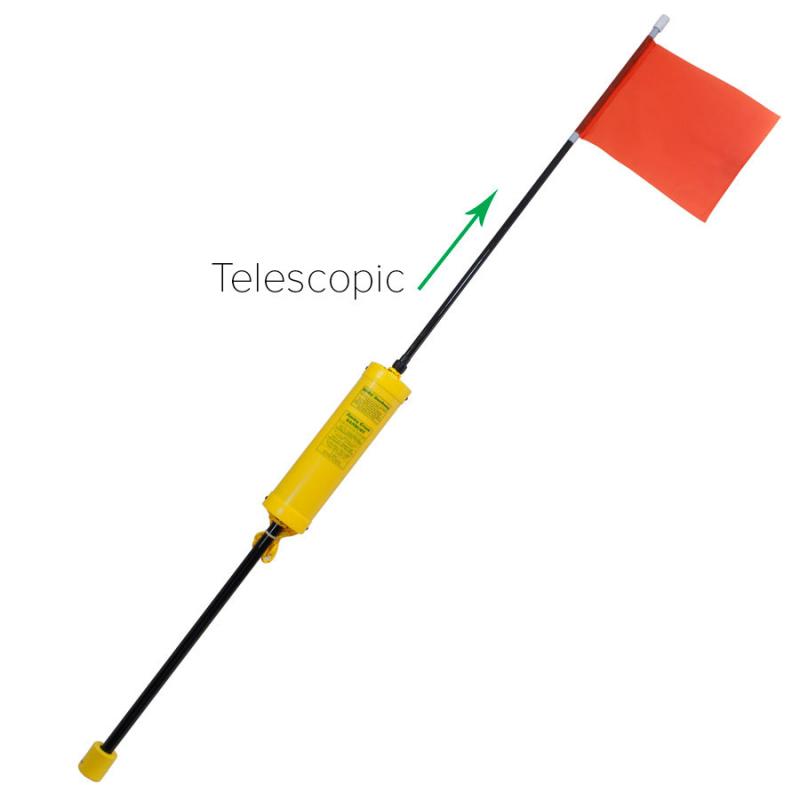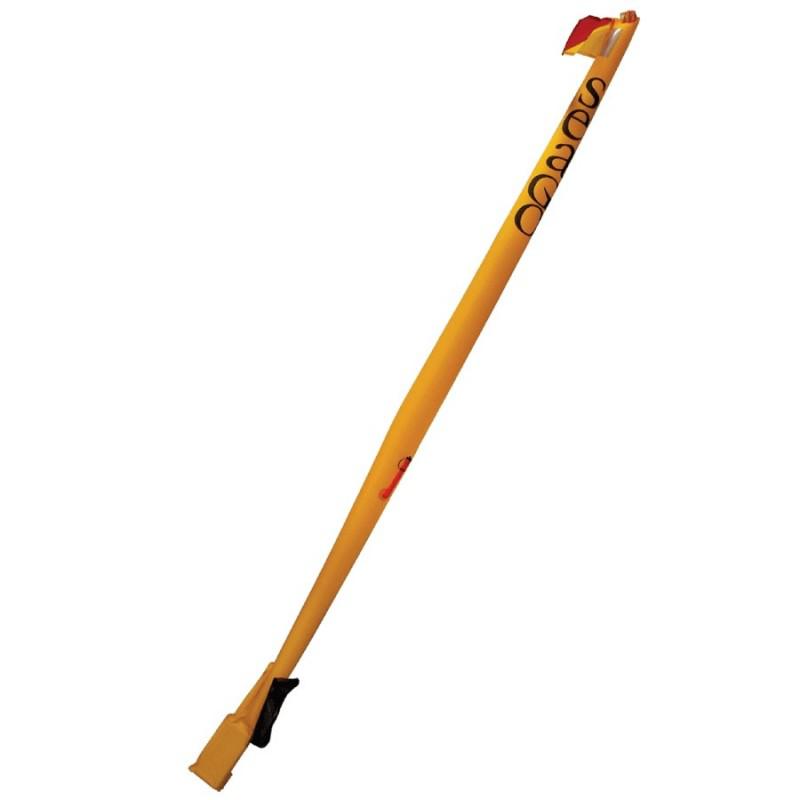Danbuoy Selection Guide
What is a Danbuoy ?
There are two major types of danbuoy: traditional and Inflatable
Traditional Danbuoys
A traditional danbuoy is a flag on a pole deployed in emergency for marking the position of a man overboard incident. The pole has a flag on the top, an integral float for buoyancy, and a weight at the bottom to keep it upright in the water. The pole needs to be long so that the flag is well above sea level for good visibility, and the weight at the bottom of the pole needs to sit deep in the water for stability and righting moment performance. The pole may be in two or more parts to make stowage easier. Tapered telescopic poles perform a similar, but more convenient function. Please note that the different parts are not considered a danbuoy unless they are all fixed together or extended, and with the flag unfurled. A light may be fitted for cruising in the hours of darkness. There are ways of automatically freeing the flag and switching on the light when the danbuoy is deployed to fulfil this requirement.

Inflatable Danbuoys
Inflatable danbuoys are based on a similar principle to an automatic self-inflating lifejacket. The danbuoy is made from similar yellow fabric to a lifejacket lung. Inflation is achieved by a water activated CO2 canister. The inflated form has an integral flag at the top of a tapering conical shaft with a bulbous section at the bottom that sits in the water. There is a fitted weight for stability, and a drogue attached for slowing the rate of drift. The unit is normally supplied in a compact stowage container suitable for rapid deployment. There are options for combining an Inflatable Danbuoy and an Inflatable Horseshoe Lifebuoy in one container.

Do I need a Danbuoy ?
There are various alternative electronic options now available, both personal and yacht based, which can pinpoint the position of a casualty in the water, and therefore perform a similar function to a danbuoy. Electronics can fail, especially in a harsh marine environment. A danbuoy is still viewed as a mandatory requirement by the world’s leading sailing authorities e.g. World Sailing (formerly known as ISAF), RORC, World ARC. However, even if you view your sailing as much more relaxed with fine weather intentions, a danbuoy is recommended by the RYA as an important part of a yacht’s safety inventory with respect to a man overboard incident.
What Type of Danbuoy Do I Need ?
The danbuoy model that you choose should match your individual requirements based on the following criteria:
- Cruising Intentions – will you be keeping to rivers, estuaries and inshore waters, venturing a little further, but staying within reach of the coast, or sailing offshore away from land ?
N.B. Other safety equipment, notably Pyrotechnics (flares) have recommendation guidelines which correlate to danbuoys:Inshore = less than 3 miles from shore
Coastal = between 3 and 7 miles from the coast
Offshore = more than 7 miles from land - Stowage and Deployment Practicalities – a danbuoy requires a quick release mounting in a practical location onboard for rapid deployment while at sea, but it could have an alternative, sheltered home avoiding sun and wind damage.
- Budget – there is a vast array of safety equipment for yachts at sea, and you may not be able to afford all of them, or not all the most expensive options, so price will inevitably be a factor.
- Daylight or Night Sailing – if you are likely to be sailing during the hours of darkness, whether intentionally or not, then a light is recommended for visibility. This narrows down the choice considerably if you require the light to be fitted to the top of the danbuoy.
- Compliance with World Sailing Regulations - you will need to ensure that your danbuoy complies with the rules for Offshore Racing and Rallying e.g. RORC, World ARC - for more guidance, consult this guide: Danbuoy Compliance
It is generally recommended that a danbuoy be located on the aft rail, close to the helmsman. The aim is to ensure the minimum delay in deployment in the event of a man overboard incident. A danbuoy may be stowed away in a sheltered location when yachts are safely moored in their home berth.
Danbuoy Options
Choose a Danbuoy to suit your requirements from our Comparison List. The Jimmy Green range of Danbuoys are named with their intended usage in mind.
1 Piece Inshore Danbuoy
- Inshore use: no more than 3 miles from land, daylight only
- One-piece rod
- No light fitting capability
- Flag height: 1.6 metres above water
- Relatively inexpensive
- Simple to mount
- Difficult to store, 2.15 metres length overall
2 Piece Inshore Danbuoy
- Inshore use: no more than 3 miles from land, daylight only
- Two-piece rod with stainless joining sleeve
- No light fitting capability
- Flag height: 1.8 metres above water
- A slight step up in price from 1 piece Inshore
- Simple to mount
- Reasonable to store, two pieces of less than 1.5 metres overall
- Extended length 2.9 metres overall
Coastal Danbuoy
- Coastal use: between 3 and 7 miles from land, daylight only, easier storage, increased flag height
- Two-part tapered telescopic rod
- Convenient simple assembly
- No light fitting capability
- Flag height: 2 metres above water
- More expensive than Inshore
- Simple to mount
- Reasonable to store, telescopic taper collapses to 1.52 metres stowed length overall
- Extended length 2.93 metres overall
Offshore and Ocean Danbuoy
- Offshore use: More than 7 miles from land, easy storage
- World Sailing (formerly ISAF) RORC and WCC compliant
- Three-part tapered telescopic rod
- Optional Automatic light
- Flag height: 2 metres above water
- More substantial and more expensive than Coastal
- Simple to mount
- Easy to store, telescopic taper collapses to 1.2 metres stowed length overall
- Extended Length 3.25 metres overall
Seago Ocean Danbuoy
- Offshore/Ocean use: More than 7 miles from land
- World Sailing (formerly ISAF) RORC and WCC compliant
- Telescopic
- LED Light
- Mountable
- Stowed length 2.1 metres, extended length 3.6 metres overall
- More expensive option
Jimmy Green offer Inflatable Danbuoys from Seago and Jonbuoy.
These are World Sailing (formerly ISAF), RORC and WCC compliant. They offer quick release, compact stowage in UV protective containers on the rail, but they are much more expensive than traditional pole danbuoys. They are fitted with a small drogue attached because their inflated shape would otherwise lead to a far greater rate of drift than traditional pole danbuoys. They also require similar servicing to an automatic lifejacket.
Seago Inflatable Danbuoy - SB2
Seago Inflatable Danbuoy - SB3
Jonbuoy DayGlo Lite Inflatable Danbuoy
Safety Equipment Advisory
All safety equipment should generally be suitable and adequate for the intended application, the yacht length/displacement, and your cruising intentions.
Regular maintenance is required to ensure that your danbuoy will function perfectly when required.
Frequent routine checks will be necessary with consequent cleaning, servicing, remedial replacement and sheltering whenever possible from the deleterious effects of a harsh marine environment. Sheltering means allocating safe storage from weathering degradation while not in active use i.e. when a yacht is in on the hard or in safe harbour.
Any expiry dates should be checked and any items nearing the end of their life should be immediately upgraded.













